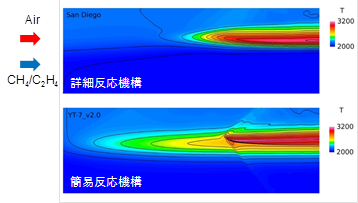Study on Future Space Transportation System using Air-breathing Engines
JAXA Supercomputer System Annual Report April 2016-March 2017
Report Number: R16E0079
- Responsible Representative: Koichi Okita(Research and Development Directorate, Unit IV)
- Contact Information: Masatoshi Kodera(kodera.masatoshi@jaxa.jp)
- Members: Masahiro Takahashi, Masatoshi Kodera, Shuichi Ueda, Masaaki Fukui, Toshihiko Munakata, Masaharu Takahashi
- Subject Category: Space(Space transportation)
Abstract
In order to reduce the cost of space transportation systems significantly, reusable rockets are considered. However, in order to extend the structural lifetime, it is necessary to operate with relatively low engine power, leading to a decrease in launch capability. Therefore, a combined cycle of a rocket and an air-breathing engine, RBCC is promising to compensate the drawback. By using air in the atmosphere as an oxidizer, it becomes highly efficient, and it can be expected to maintain and improve the launch capability even if it is reused. In this project, we will research and develop key technology for practical application of the RBCC engine.
Goal
Future space transportation system requires low cost and high efficient engines. The purpose of the project is to study a rocket based combined cycle (RBCC) with an air-breathing scramjet, which offers a great potential to satisfy the feature.
Objective
The final goal is the practical application of a two-stage to orbit (TSTO) system using the RBCC engine, but as a preliminary step, we will aim at demonstrating key technology associated with the engine by ground and flight experiments.
References and Links
N/A
Use of the Supercomputer
The supercomputer is used to apply CFD to elucidating internal flow structures important for the design of the engine and investigating the working characteristics, since information only obtained from experiment is insufficient.
Necessity of the Supercomputer
The following points are raised as problems of engine design by ground experiments. 1) There are limits to reproducing various airflow conditions from takeoff to hypervelocity range. 2) Measured values are limited and complicated three-dimensional flow structure inside the engine can not be well identified. 3) Since the time and cost are limited, it is not easy to change the engine flow path configuration. Therefore, it is indispensable to utilize 3D CFD as a design tool, and as supercomputer is required for performing numerous CFD works efficiently.
Achievements of the Year
Case1
We conducted a collaborative research with Tohoku University on simplifying reaction mechanism of high molecular hydrocarbon pyrolysis fuel. In this fiscal year, we constructed several simple reaction mechanisms on methane / ethylene mixture proposed by NASA as a surrogate fuel of jet fuel and validated them by comparing with a detailed reaction mechanism for CFD of 2D supersonic Caption of Fig.1 combustion shear flow.
Case2
We proceeded to prepare for application of the LS-FLOW solver to the scramjet combustor flow simulation and started the validation computation for the scramjet combustor test using hydrocarbon fuel (ethylene).

Fig.1(Case1):Comparison between CFD results with simple and detailed reaction mechanisms: 2D supersonic combustion shear flow
Publications
N/A
Computational Information
- Parallelization Methods: Process Parallelization
- Process Parallelization Methods: MPI
- Thread Parallelization Methods: n/a
- Number of Processes: 32, 320
- Number of Threads per Process: 1
- Number of Nodes Used: 1, 10
- Elapsed Time per Case (Hours): 10, 250
- Number of Cases: 2, 20
Resources Used
Total Amount of Virtual Cost(Yen): 14,139,221
Breakdown List by Resources
| System Name | Amount of Core Time(core x hours) | Virtual Cost(Yen) |
|---|---|---|
| SORA-MA | 791,994.33 | 1,278,545 |
| SORA-PP | 622.36 | 5,314 |
| SORA-LM | 0.00 | 0 |
| SORA-TPP | 0.00 | 0 |
| File System Name | Storage assigned(GiB) | Virtual Cost(Yen) |
|---|---|---|
| /home | 427.70 | 3,718 |
| /data | 9,708.33 | 84,710 |
| /ltmp | 6,184.90 | 53,019 |
| Archiving System Name | Storage used(TiB) | Virtual Cost(Yen) |
|---|---|---|
| J-SPACE | 4.90 | 13,912 |
Note: Virtual Cost=amount of cost, using the unit price list of JAXA Facility Utilization program(2016)
JAXA Supercomputer System Annual Report April 2016-March 2017




